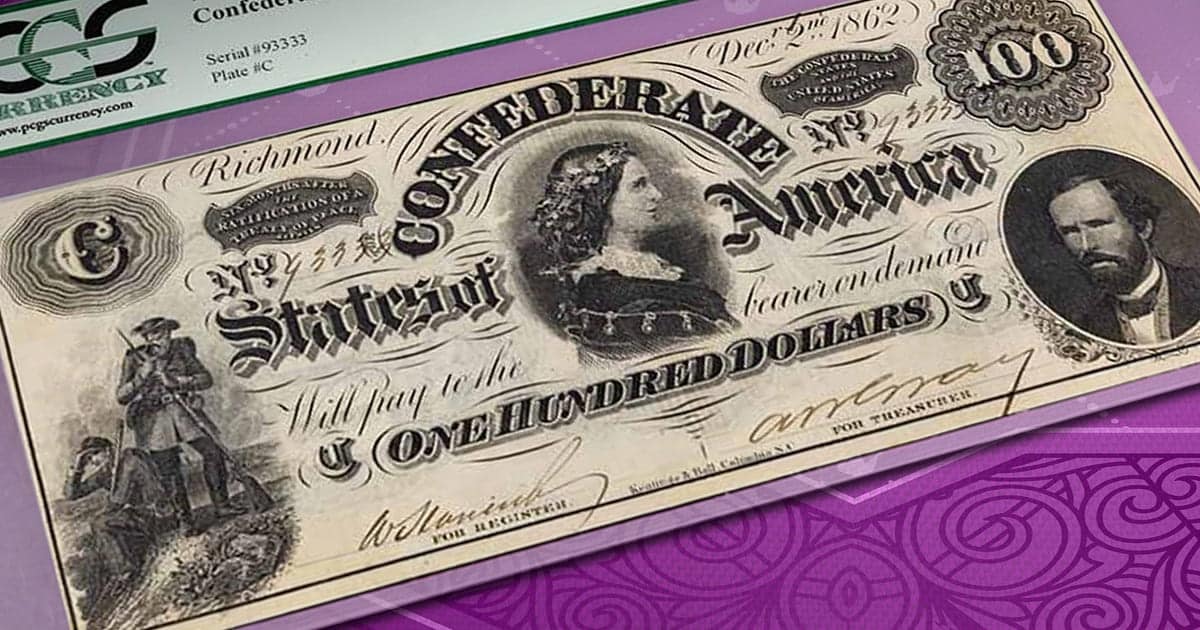
Lucy Pickens Legacy and the $100 Confederate Bill
Currency collectors familiar with Confederate currency know the name – Lucy Pickens. Her portrait is prominent on a $100 CSA note that was issued in 1862, 1863 and 1864. But who was she and why was her portrait prominent on that CSA note for 3 out of the 4 years that they printed currency?
Lucy Petway Holcombe Pickens was born in 1832 at her family’s plantation in La Grange, Tennessee. At age 25, Lucy met Colonel Frances Wilkinson Pickens who was much older than her and tried to court her. She wasn’t interested until Colonel Pickens was appointed Ambassador to Russia. In 1857 she had a change of heart and by the following year they were married.

Lucy and the new Ambassador left for Russia and were very well received at the Russian Court of Tsar Alexander II. While serving in Russia, the Pickens’ had a daughter – Francis Eugenia Olga Neva Pickens. The Tsar and Tsaritsa were godparents to the child. Although they were happy in St. Petersburg, the worry about secession and the slavery issue caused them to return home in August of 1860.
They settled in South Carolina and Colonel Pickens was elected as Governor by the General Assembly on December 17th, just 3 days before the state legislature voted to secede from the Union. In April of 1861, she and her family witnessed the shelling of Fort Sumter in Charleston harbor by the new Confederate Army. They watched from the rooftops of Charleston buildings as did many South Carolinians.

They both worked diligently on the side of the Confederacy – he by governing the first state to secede and keeping it loyal to the Confederacy and she by raising money and inspiring other Southern women to help their Southern men by volunteering in hospitals and selling their jewelry for the cause.
She came to be greatly admired within the Confederacy and her popularity grew. She relished the fame and encouraged those who named her the “Queen of the Confederacy.” By all accounts she did shape the stereotype of the typical “Southern belle” – ready to defend her beliefs from the Northern Aggressors. She advocated secession at every opportunity and encouraged life on the plantations to go on as it previously had for decades.
The Governor and Mrs. Pickens and their daughter now spent the war years between two locations – the Governor’s mansion in South Carolina and the Pickens plantation, with Lucy spending much more time running the plantation. But during the war years it was difficult to keep the plantation productive without the help of hundreds of slaves, many who had fled at the outbreak of the Civil War.
The Confederate States of America was printing its own currency to finance its war debts, pay its soldiers, and to pay its obligations to England and other European countries with whom it traded. Many Confederate heroes were portrayed on their currency – President Jefferson Davis, General Stonewall Jackson, President of the United States George Washington – as a Virginian the Confederate States claimed him as a loyal son of the South, and many Confederate States of America cabinet officials.
Life in the Southern States was also depicted as Sailing Ships, Trains, Confederate Soldiers and Slaves Hoeing Cotton were all subjects on Confederate currency. But the only woman depicted on any CSA currency is Lucy Pickens – the Queen of the Confederacy.

She is depicted on a $100.00 Confederate note issue dated in 1862, 1863 and 1864. Only the color of the note itself and some of the printing changed from year to year. The images on the notes did not change annually.
Her portrait also graces a $1 bill from 1862. There she is depicted with a paddlewheel steamer at the center, Miss Liberty at left and Mrs. Pickens at the right. She is truly representative of “Southern Womanhood.”

Once the war ended and their previous slaves were freed men, the Pickens family sold family jewels and treasures to now pay these freed men. Many stayed on the plantation but now worked as sharecroppers so life for the Pickens family required major adjustments.
After the War had ended, former Governor Pickens had to decide whether to choose the oath of loyalty to gain he amnesty that was being offered or to remain loyal to the defeated cause and lose all financial possessions. Pickens chose the oath and he was pardoned.
In 1869, former Governor Pickens died and Lucy was now a widow at age 37 and had to manage the family’s financial affairs and run the plantation – but under the new rules that prevailed. During those 30 years after her husband had died, she still tried to live like a genteel Southern “lady of the manor.” She served as Vice Regent for the state of South Carolina for the Mount Vernon Ladies Association which was formed to preserve George Washington’s plantation.
By 1899, Lucy’s health failed and she die of a cerebral embolism. She is buried in her Southern soil, next to her husband and daughter in South Carolina. The “Queen of the Confederacy” lives on in these historic pieces of Confederate States currency. If you are interested in building your collection of Confederate currency, shop our assortment today.
If you are looking for great deals on currency and collectible notes for Black Friday 2022, we are offering hundreds of rare coins, ancient coins, currency, and collectible notes on sale beginning on Black Friday at 11:00 PM EST. Don’t wait- This sale ends on Sunday the 27th at 11:00 PM EST.





